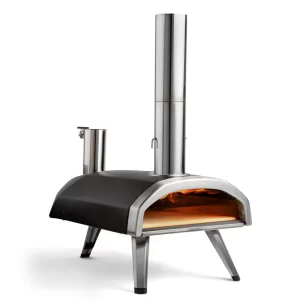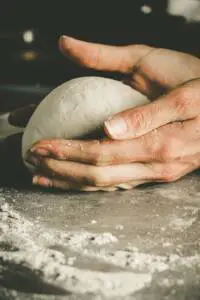Welcome to the wonderful world of leopard crust pizza! Have you ever tried a pizza with those beautiful black spots on the crust? That’s what we call “leopard crust,” and it’s a special feature that makes Neapolitan pizza truly unique and mouthwateringly delicious!
What is Leopard Pizza Crust?
Leopard crust pizza gets its name from the attractive black spots scattered on the pizza crust, like the pattern on a leopard’s fur. These black spots are purposely created and are a trademark of a true Neapolitan pizza.

Why is Leopard Crust So Special?
- Ah, the magic of leopard crust lies in the taste! Those black spots add a smoky and rich flavor that pairs perfectly with the cheesy goodness and sweet tomato sauce of the pizza.
- But wait, don’t confuse these spots with a burnt crust; they are carefully spaced out and cover only the outer crust, leaving the inner part chewy and scrumptious.
A Bit of Pizza History
- Leopard crust is famously linked to Neapolitan pizza, which is a traditional Italian pizza style loved by pizza enthusiasts all around the world.
- In fact, some pizza experts believe that a true Neapolitan pizza must have that charming leopard crust. So, you see, it’s more than just spots on the crust; it’s a mark of authenticity!
Embrace the Leopard Crust
- Now, you might be thinking, “Can I make leopard crust pizza at home?” Of course, you can! With a bit of pizza magic, you can create this delightful crust right in your kitchen.
- Whether you have a fancy pizza oven or a regular oven, as long as you follow some simple steps, you can enjoy the goodness of leopard crust.
Achieving Leopard Crust with High Hydration Dough
To work this magic, skilled pizzaiolos use dough with high hydration. Hydration simply means the amount of water in the dough. For leopard crust, we use dough with a high percentage of water, around 70%. It’s like a wet and sticky ball of dough!
The Hero: High Gluten Flour
To handle this high hydration dough, pizzaiolos turn to a superhero flour called “00 flour.” It’s high in gluten, which gives the dough the strength it needs to hold all that water. With 00 flour on our side, we’re ready to embark on the leopard crust adventure!
Extreme Heat for the Spots
Now, it’s time to meet the blazing star of the show: the oven! To create those beautiful black spots, we need temperatures soaring above 800°F (that’s really hot!). This is where a wood-fired pizza oven comes into play, infusing the crust with intense heat and causing the leopard pattern to emerge.
Why You Should Leopard a Pizza Crust
Leopard crust on pizza is not just a fancy pattern; it brings a whole new dimension of flavor and texture that makes it worth trying. Here’s why you should definitely give it a go:
Flavorful Delight
The secret behind leopard crust’s allure lies in its unique flavor profile. Those black spots add a delightful smokiness and richness to the pizza, elevating the taste to a whole new level.
Spot the Difference
A burnt crust can leave a bitter taste in your mouth, and it’s definitely not what we’re aiming for. Leopard crust, on the other hand, strikes the right balance, creating an enticing visual and flavorful treat.
A Challenge Worth Taking
Handling the high-hydration dough, getting the oven temperature just right, and mastering the timing are all part of the adventure. It might take a few tries, but the end result is oh-so-rewarding!

How to Leopard a Pizza Crust at Home
Now that you’re excited to create your very own leopard crust pizza, let’s dive into the step-by-step guide on how to achieve this delightful crust right in the comfort of your home!
Related Topics:
1. Preparing Well-Hydrated Dough for Leopard Crust Pizza
Ingredients:
- 2 ¾ cups 00 flour
- ¾ cup lukewarm water (105-110°F)
- 1/2 tablespoon salt
- ¾ teaspoon active dry yeast
- ¼ cup extra virgin olive oil
- 1 tablespoon honey
Step-by-Step Guide:
- Proof the yeast: In a bowl, mix the yeast, lukewarm water, and honey. Let it sit for around 10 minutes until it becomes foamy and activates the yeast.
- Prepare the dry ingredients: In another bowl, mix the 00 flour and salt together.
- Combine the wet and dry ingredients: Slowly mix the activated yeast mixture into the dry ingredients. Add half of the yeast mixture, then incorporate some olive oil, and finally, mix in the rest of the yeast mixture. The dough will be sticky and gooey, and that’s perfect!
- Let it rest: Cover the dough and let it rest for 15 minutes.
- Mix again: Use a silicone spatula to mix the dough a few more times.
- Let it rise: Cover the dough again and let it rise until it doubles in size, which usually takes around 2-3 hours.
- Divide the dough: Once the dough has risen, divide it into separate dough balls. This recipe makes two 12-inch pizzas or several smaller ones.
- Let the dough rest again: Lightly flour each dough ball and let them rest for another hour.

2. Achieving Leopard Crust with a Regular Convection Oven
Using a regular home oven to create leopard crust is possible with a combination of high heat and the broil setting.
Ingredients:
- Well-hydrated pizza dough
- Pizza stone
Step-by-Step Guide:
- Preheat the oven: Set your oven to the highest temperature, which is usually around 550°F (approximately 280°C). Make sure to heat your pizza stone first.
- Bake and broil: When you put your pizza in the oven, turn down the temperature to 400°F (approximately 205°C) while turning on the broil setting.
- Get close to the broiler: Raise your oven racks so that the pizza is as close to the broiler as possible.
- Monitor the process: This process is relatively quick, and every home oven is slightly different. Keep an eye on the pizza to ensure it doesn’t burn.
3. Using a Pizza Stone and High Heat for Even Cooking
The pizza stone helps distribute heat evenly, ensuring a perfectly cooked leopard crust.
Ingredients:
- Well-hydrated pizza dough
- Pizza stone
Step-by-Step Guide:
- Preheat the oven: Turn your oven to the highest temperature, typically around 550°F (approximately 280°C). Preheat your pizza stone inside the oven.
- Transfer the pizza: Once the oven and the stone are hot, carefully place your pizza on the preheated stone.
- Even cooking: The pizza stone holds the heat and ensures even cooking, resulting in a crispy crust with those delightful leopard spots.

Tips for Maximum Heat in a Home Oven
Achieving high heat in a home oven might be challenging, but here are some tips to get the best results:
- Utilize the broiler: Use the broiler setting to get additional heat from the top, mimicking the effect of a wood-fired oven.
- Keep the pizza close: Position the pizza as close to the broiler as possible, ensuring it gets the intense heat needed for leopard crust formation.
Pro Tips for Getting Leopard Pizza Crust at Home
Making leopard pizza crust at home may sound like a daunting task, but fear not! With these pro tips, you’ll be on your way to achieving that irresistible leopard spotting on your pizza. Let’s dive in:
Proper Dough Temperature and Hydration
- Achieving the perfect leopard crust starts with getting the dough temperature and hydration just right.
- Keep the dough at room temperature before use to avoid a pale crust with burnt spots. Cold dough won’t cook properly.
- Aim for a dough hydration of around 70% for a light, airy, and puffy crust with the desired leopard spots.
- Using 00 flour, high in gluten, is ideal for achieving the best results.
Benefits of 00 Flour and Honey
- Opt for 00 flour as it enhances gluten development, leading to better leopard spotting.
- Honey is an excellent choice for proofing yeast as it fuels the yeast and aids caramelization for the perfect spots.
Quick Fixes for Over-Fermented Dough
- Don’t worry if your dough is over-fermented; you can still salvage it!
- Dust the dough ball with flour, stretch it out, and it’ll be ready to use. Professionals can try ripping the surface, but it requires skill.
- If the dough is slightly brown and not charred, and there are many small leopard spots and occasional large ones, your pizza crust is perfect.

FAQ- Frequent Asked Questions Regarding Leopard Crust Pizza
- Why is leopard crust significant in Neapolitan pizza?
- Leopard crust is a defining characteristic of authentic Neapolitan pizza, representing the perfect balance between a crispy outer layer and a light, airy interior. It adds a delightful contrast of flavors, enhancing the overall pizza experience.
- Can I achieve leopard crust with a regular oven at home?
- Yes, you can! While a wood-fired pizza oven is ideal for leopard crust, a regular home oven can also produce satisfying results. Use a pizza stone, preheat the oven to the highest temperature, and use the broiler setting to create the necessary heat.
- How can I get maximum heat for leopard crust in my oven?
- To achieve maximum heat for leopard crust, utilize your oven’s broiler or grill function in addition to preheating the pizza stone. Place the pizza stone on the top rack and position the pizza close to the broiler, ensuring even cooking from the top and bottom.
- What is the ideal pizza dough hydration for leopard crust?
- For the perfect leopard crust, aim for around 70% hydration in your pizza dough. This level of hydration allows for the desired puffiness and steam generation, resulting in the characteristic leopard spots.
- Is leopard crust safe to eat?
- Absolutely! Leopard crust is not burnt; it’s a sign of high-quality Neapolitan pizza. The smoky flavor it imparts enhances the pizza’s taste. Wood-fired Neapolitan pizza contains gluten but is generally considered healthy, with around 900 calories per pizza.
- How can I achieve the perfect leopard spotting on my pizza crust?
- The key to achieving the perfect leopard spotting lies in proper fermentation and developing an irregular textured surface on the dough. Use high heat, whether in a wood-fired or well-preheated domestic oven, to create the desired leopard pattern.
Conclusion
Leopard crust pizza adds that magical touch to your pizzas, making them extraordinary culinary masterpieces. Whether you’re a pizza aficionado or a budding home chef, don’t miss out on the flavorful journey that leopard crust has to offer. It’s time to roll up your sleeves, put your culinary skills to the test, and create pizzas that will leave your taste buds dancing with joy!
So, grab your apron, knead that dough, and let the leopard spots adorn your pizza creations. With each savory bite, you’ll savor the smoky richness and delightful contrast, knowing that you’ve mastered the art of leopard crust pizza. Bon appétit!







